Foreword

One of the Sherman Technical Manuals refers to a "Speed Caution Plate" affixed to the hull wall to the left of the driver's seat. We prefer to use the informal term "dataplate." Not many surviving Shermans still have them. Most that do, have replacement plates, added during rebuild programs. Original Sherman dataplates include the name of the company that manufactured the tank (in the area highlighted in green). The Ordnance Serial Number was stamped in the box in the upper right hand corner (highlighted in red). In most cases, the year of acceptance was stamped inside the box on the lower left (highlighted in blue). In general, the initials of the Chief of the relevant Ordnance District were stamped inside the box on the lower right (highlighted in yellow). All of the M4 series dataplates we have encountered to date appear to have been made of embossed metal. Before the advent of the Sherman, US built tanks, including the Lee/Grant series, are seen with dataplates made of cast brass. It is thought that the use of brass was discontinued for reasons of conservation. Unfortunately, the “pot metal” that replaced the brass has not held up well, and many surviving Sherman dataplates are rusted unreadable. Indeed, a Product Correction Report from the Ordnance Officer at Ft. Knox regarding Ford M4A3 Serial Number 2681 stated that “The serial number plate was rusting badly; evidently made of steel with a thin plating of nickel or cadmium.” The rapid deterioration is evidenced by the fact that Serial Number 2681 would have been accepted in September, 1942 and the PCR is dated November 9, 1942. In any case, we don’t find that a more durable material was subsequently used for the plates as recommended, so should any readers be in the position to photograph examples of readable dataplates, we would be happy to see them, and hope we might be permitted to use such photos to enhance this piece.
Original WW2 plates
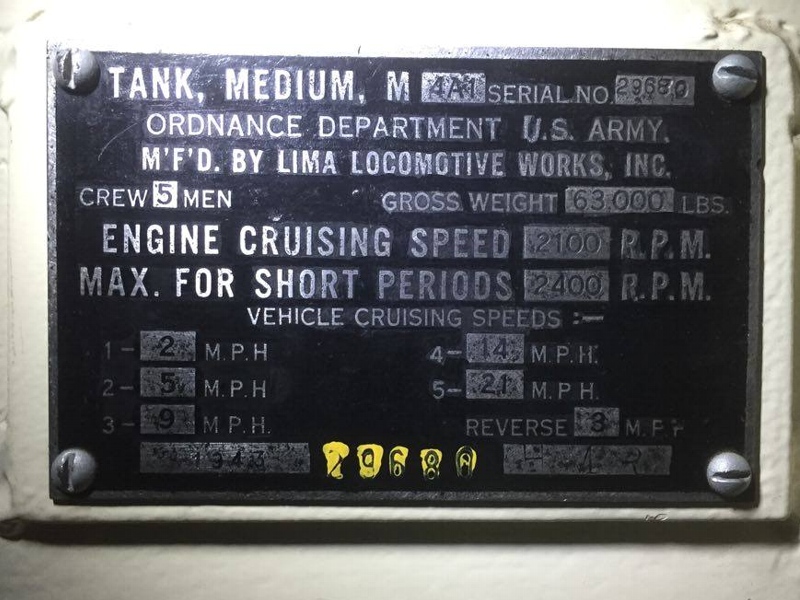
Lima Locomotive Works, Inc. - M4A1 75mm Sherman - Serial number 29680 - built in March, 1943
This dataplate has been restored somewhat, and is a fine example of the original “Speed Caution” type plate as used on First Generation Shermans, and some early Second Generation models produced up to and including April, 1944. The year, 1943, can be seen stamped into the box at the lower left, and we would observe that the vast majority of Sherman/variant dataplates examined provide only the year of production. “H M R” can be seen stamped into the box at the lower right. Marco Hogenkamp has done a study of the Chiefs of the various Ordnance Districts in the US during WW II. These Officers were responsible for seeing to it that the vehicles accepted by the US Government were built and tested to the prescribed standards. Marco’s notes have it that Col. Harold M. Reedall was Chief of the Cleveland Ordnance District from 6 July 1940 until 16 May 1944. Lima, Ohio was within the Cleveland Ordnance District, and, by having his initials stamped into the dataplate, Col. Reedall gave Serial number 29680 his “seal of approval” at acceptance. For those wishing to make reproduction dataplates, we would mention that the additional stamping of the Serial Number outlined in yellow, is not seen on other examples, and is believed to have been done long after this plate was first installed inside of this Sherman. Photo courtesy of Chris Till.


Chrysler Corporation - M4 105mm VVSS Sherman - Serial number 57568 - built in August, 1944

Chrysler
Tank Arsenal - M4A4 75mm Sherman (converted to Firefly) - Serial number 16733 -
produced in December, 1942.
Above shows the
deteriorated but still readable dataplate from the Sherman V Firefly on display
at the Pansarmuseet in Axvall, Sweden. The Serial Number 16733 is stamped in
the upper right hand corner, indicating that this M4A4 was accepted in
December, 1942. The tank as it is displayed shows obvious signs of having been
one of the 1610 M4A4s remanufactured by Chrysler for British Lend Lease. We
suspect that, during remanufacture, Chrysler replaced the original dataplate,
which would have had the year “1942” stamped inside the box on the lower left,
with this one stamped with “1944.” Note that the initials of Brig. Gen. Alfred
Bixby Quinton Jr. can be seen stamped inside the box on the lower right. It may
be of interest that this M4A4 dataplate refers to “Chrysler Tank Arsenal,”
while the plate from the M4(105) cited in the previous caption was “M’F’D By
Chrysler Corporation.”


The Baldwin Locomotive Works - M4 75mm Sherman - Serial number 16261 - built in January, 1944
Here is a photo of the original Baldwin dataplate from Serial Number 16261. With the exception of Pacific Car & Foundry, original Sherman dataplates only list the year of production in the box at the lower left. Of the 1233 M4s made by Baldwin Locomotive, all but the last 43 were produced in 1943. Note that “1944” is stamped into the box, indicating that it was one of the units accepted in January, 1944, the last month of production at Baldwin. Considering all of the changes that had been made to the Sherman by the beginning of 1944, it seems odd that Baldwin M4s “still” had direct vision at that late date. The initials “ D N H” can be seen stamped into the box at the lower right. Col. D. N. Hauseman was the Chief of the Philadelphia Ordnance District from August, 1942 through December, 1943, and oversaw operations at the Baldwin Plant. He was replaced by Col. F. A. McMahon in December, but despite that, his initials appear on this January, 1944 production M4. Photo courtesy of Col. Renato Rocha.


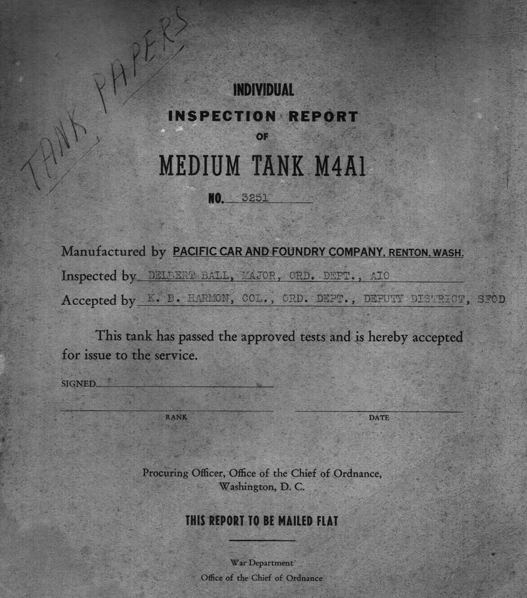
Pacific Car and Foundry - M4A1 75mm Sherman - Serial number 3049 - built in September, 1942
Remanufactured in November 1944 by Chrysler Evansville Ordnance Plant.

Federal Machine and Welder - M4A2 75mm - Serial Number 14962 - built in May, 1943
Federal Machine and Welder was one of the smaller manufacturers of Shermans, producing only 540 M4A2(75)s from December 1942 through December 1943. FMW’s M4A2s were assigned Serial Numbers 14785 through 15324. Many surviving Shermans are missing their dataplates, most likely because they were removed for souvenirs. That appears to have been the case with this particular example as the plate was found in a barn in France. Serial Number 14962 would have been accepted in May, 1943. The Number “178” can be seen stamped rather large in the lower center of the plate. We would note that SN 14962 was the 178th M4A2 accepted at FMW ( Build sequence # 1 = SN 14785, plus 177 units = SN 14962). Thus, this single example at least seems to suggest that the company may have stamped the build sequence number on its dataplates? We hope to come across some other FMW plates to confirm or refute the build sequence theory. Photo provided by Arnaud Marquet.
American Locomotive Company - M4 75mm, Serial Number 1801, accepted in April, 1943.
This tank was one of 53 M4 Shermans shipped to Brazil as Lend Lease in 1944. It is currently on display as a monument at the "Patio dos Blindados" at the Headquarters of the 1º Regimento de Carros de Combate, Santa Maria, Brazil. Colonel Renato Rocha, commanding officer of the 1º RCC, reported that, “In 1945, my Regiment received all 53 M4s and have used them until 1972 when they where exchanged by M41A3 Walker Bulldog.” Photo courtesy of Col. Renato Rocha.

M4 Composite (converted to Firefly Hybrid Ic) - Serial number 40319, accepted in October, 1943.
This tank is on display at the Museum of Military History, Johannesburg, South Africa. The American Locomotive Company or ALCO produced 2300 M4A2 and M4 Shermans from September, 1942 through December, 1943. All of their M4A2s and most of their M4s were all welded hull models, but in their final months, the company built an as yet undetermined number of M4 Composites, such as SN 40319. The ALCO plant was located in Schenectady, New York, and was part of the Rochester Ordnance District. For most of WW II, Col. Frank J. Atwood was Chief of the Rochester O.D., and his initials can be seen stamped into the box at the lower right of the plate. Photo courtesy of Museum of Military History, Johannesburg.

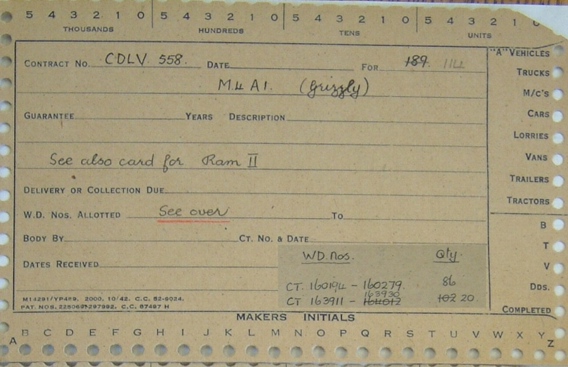
Montreal Locomotive Works, Ltd - M4A1 75mm Sherman Grizzly - Serial number 163973
The first line of the original "Speed Caution" dataplate identifies the type of Sherman, and provides its Serial Number. The second line is “Ordnance Department, U.S. Army,” the organization that contracted with the various manufacturers for the production of the vehicles. In the case of the 188 Grizzlies produced by Montreal Locomotive Works, the contracting firm was the “Dept. Of National Defence, Canada.” Grizzly dataplates are stamped a bit differently, in that the Serial Number in the box at the upper right is the War Department Number assigned by the British. The document below the image of the dataplate shows the WD Numbers that were assigned. Apparently there was some uncertainty about the final quantity that was to be produced, as evidenced by the fact that some of the figures were crossed out. Our “counting heads” method confirms that, in the end, 188 Grizzlies were produced, and that they were assigned WD Numbers CT.160194 through CT.160279 for the first 86, and CT.163911 through CT.164012 for the last 102 units. We would note that the WD Number is what is seen painted on British tanks, with the “T” prefix indicating a “Tank.” The Grizzlies were given a “CT” prefix, the “C” no doubt meaning “Canadian.” On Grizzly dataplates, the year is not stamped into the box at the lower left. Instead it contains the Dept. Of National Defence, Canada or DND Number. In the example shown above, it is 62-769. Finally, the box at the lower right contains both the year of production, and what are assumed to be the initials of a Government official who inspected and/or accepted the vehicle. What is NOT included on the Grizzly dataplate is the “Shop Number,” which we take to be the equivalent of the US Ordnance Serial Number. The “Shop Number” is stamped on the front of the hull, just below the General Steel (G in a shield) caster’s logo. The examination of surviving Grizzlies confirms that these ran from 1 to 188, and that there is a mathematical relationship between the Shop Number and the WD Number. That is, if the SN is known, it is possible to derive the WD Number, and vice versa. The example shown here is Shop Number 149, and the tank is on display at the Muckleburgh Collection in Great Britain.
Pressed Steel Car - M4 75mm Sherman - Serial number 811 - built in November, 1942
With kind permission from Saumur Tank Museum.
Currently displayed at the Tank Museum at Bovington (UK), Serial Number 9992 is a Sherman III DD, the only surviving example with its original floatation screen intact. The initials "E A B" seen stamped in the box at the lower right are not those of Brigadier General Thomas S. Hammond, who was Chief of the Chicago Ordnance District at the time. However, we can observe that "E A B" has been noted on another Pullman M4A2 dataplate that we would judge to be authentic. Perhaps, as was the case with the Pacific Car dataplate, they are the initials of an Army Ordnance Inspection Officer assigned to the Pullman Plant? As far as we have been able to determine, Pullman did not stamp the Serial Number anywhere on the exterior of their Shermans, so we are particularly grateful to the staff at the Tank Museum for providing us with a photo of this dataplate, and permitting us to use it on our page.

Pressed Steel Car Co. Inc. - M4A1 76mm (wet) Sherman - Serial number 52460 - built in October, 1944


Like Pullman Standard, Pressed Steel Car was in the Chicago Ordnance District. "GRUHLKE" is seen stamped in the box at the lower right on this and a few other original PSC M4A1(76) dataplates. Of course, these are not the initials of B.G. Thomas S. Hammond, or Col. John Slezak who replaced him as Chief of the Chicago O.D. in June 1944. We had speculated that "Perhaps, "GRUHLKE" was the surname of the Army Ordnance Inspection Officer assigned to the PSC plant?" And then in early 2024, one of our readers, Jeff Wszolek, wrote to tell us that he had stumbled on Mr. Gruhlke's unusual surname "while researching US armor-piercing ammunition production at the National Archives in Chicago." Turns out Leonard Gruhlke was the head of the Inspection Department at PSC, as shown in a snippet of the document Jeff examined. Thanks, Jeff! Dataplate photo courtesy of Daniel Röttger.

Chrysler Corporation - M4 105mm VVSS Sherman - Serial number 57123 - built in April, 1944


Chrysler Corporation - M4A3 76mm HVSS Sherman - Serial number 45460 - built in August, 1944

Fisher Body - M4A3E2 "Jumbo" Assault tank - Size / Weight plate
Photo courtesy of Chris Hughes
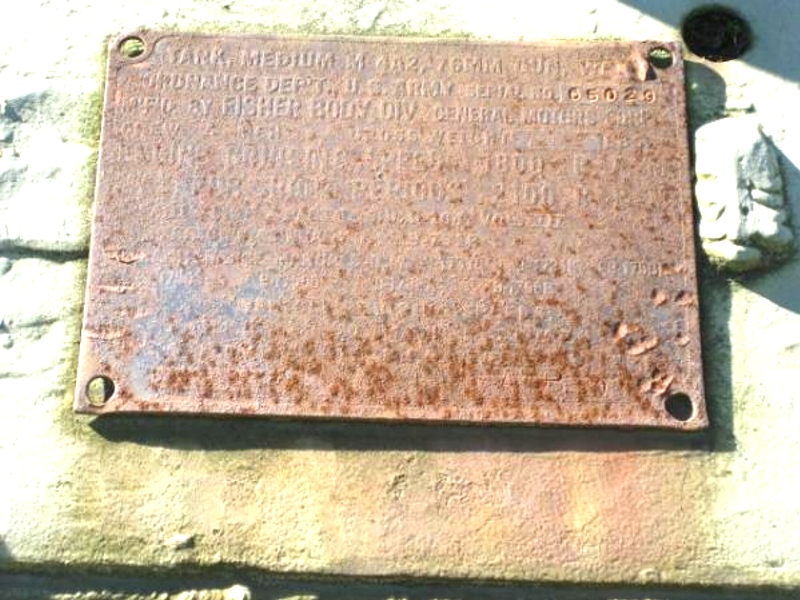
Fisher Body Div. General Motors Corp. - M4A2 76mm HVSS - Serial number 65029 - built in March, 1945
This dataplate has been removed from inside, and placed on the glacis of the M4A2(76)HVSS on display as a monument in Stanstead, Quebec Province in Canada. Serial Number 65029 would have been one of the 300 such Shermans purchased by Canada in 1946. Note that the first line reads, “TANK, MEDIUM M4A2, 76MM GUN, WET.” The gun type is no longer in parenthesis, and “WET” has been added to the tank nomenclature, to indicate that the main gun ammunition incorporates the so called “wet stowage” system. A surprising omission on original Sherman dataplates is that there is no indication on the first line that a particular vehicle is equipped with Horizontal Volute Spring Suspension (HVSS). It might be inferred from the “Fighting Weight,” which in the case of a 76mm M4A2 or M4A3 with HVSS appears to have been 75900 pounds. Considering that HVSS cost about $2000 more and added over 2 tons to the weight, one would think that it would have been included on the nomenclature line.
Photo courtesy of Waymarking website
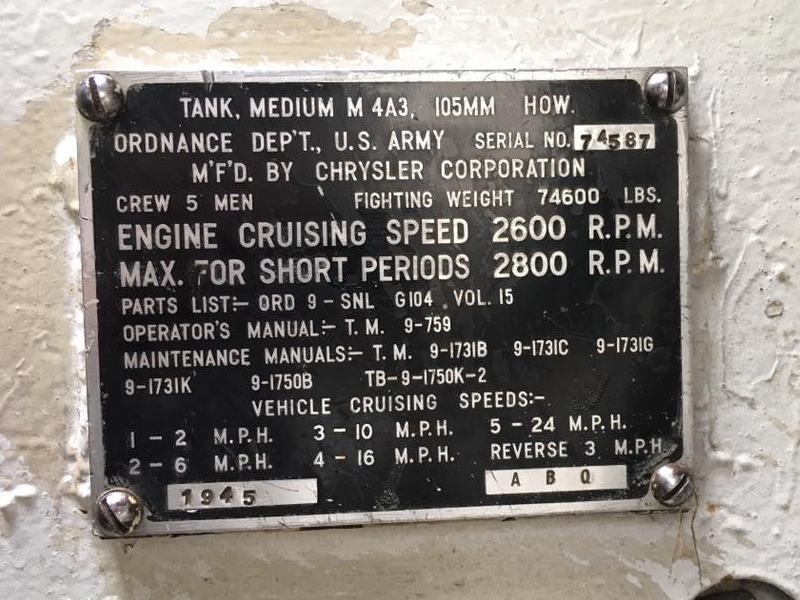
Chrysler Corporation - M4A3 105mm HVSS - Serial number 74587 - built in May, 1945
Photo courtesy of Hanno Spoelstra.
Tank destroyers, self-propelled artillery on M4 Sherman chassis
Original WW2 plates

Fisher Body Div. General Motors Corp. - M10 Tank Destroyer - Serial number 629

Fisher Body Div. General Motors Corp. - M36 (T71) Tank Destroyer - Serial number 227
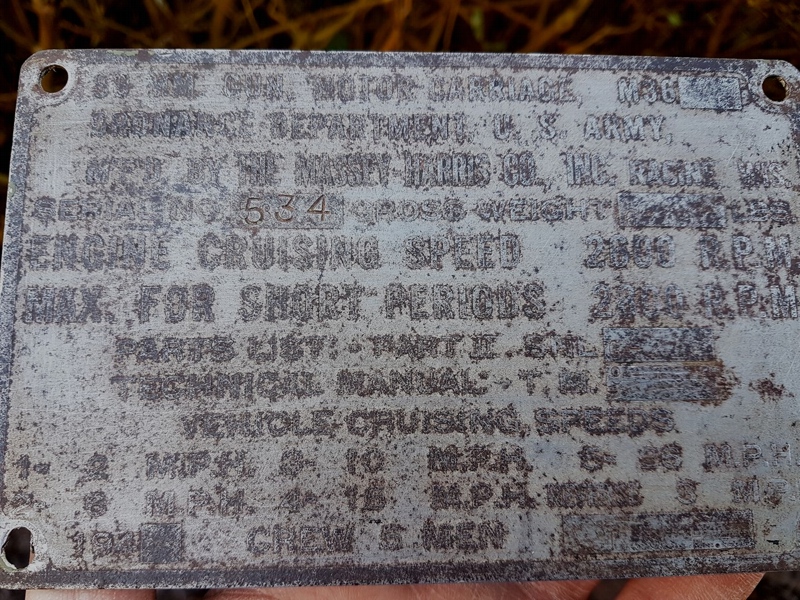
Massey Harris Co., Inc. - M36 Tank Destroyer - Serial number 534

American Locomotive Co. - M36 Tank Destroyer - Serial number 1147

An original ALCO M7 dataplate from Serial Number 385. This Priest would have been accepted in August 1942. For some reason, M7s Serial Numbers 3 through 602 were assigned "tank" Registration Numbers which began with "30", in this case USA 3034616. Starting in September 1942 with SN 603, Priests were given RNs that began with "40", the number prefix generally assigned to self-propelled guns, half-tracks and tank recovery vehicles. This is a dataplate only submission, but counting heads suggests SN 385 would have been built with such early features as the "shallow pulpit" and the hinged stowage boxes on the rear sponsons. Again, we have the initials of Col. Frank J. Atwood, Chief of the Rochester Ordnance District stamped in the box at the lower right. Photo courtesy of Christopher Bailey.

American Locomotive Co. - M7 105mm Howitzer Motor Carriage (M7 Priest) - Serial number 2588
Here we have another ALCO M7 dataplate from SN 2588, which would have been accepted in May 1943. We would expect the dataplates from a single manufacturer to be the same throughout the production run, but looking at the photos, the dataplates of 385 and 2588 are noticeably different in appearance. SN 2588 appears to be a casting with fairly bold raised numbers and letters, while SN 385 is more subdued. We can only guess that ALCO ordered some different plates at some point.

M7 series dataplates were affixed above what is called the "driver's door" as shown above. This photo was taken inside of an early M7 with an unknown SN of 2 or 3 digits. The dataplate appears to be more like the one from SN 385, but with a dark background.

Pressed Steel Car Co. - M7B1 105mm Howitzer Motor Carriage (M7B1 Priest) - Serial number unknown

Pressed Steel Car Co., Inc. - M40 155mm Howitzer Motor Carriage - Serial number 5

Pressed Steel Car Co., Inc. - M32B1 Tank Recovery Vehicle - Serial number 793
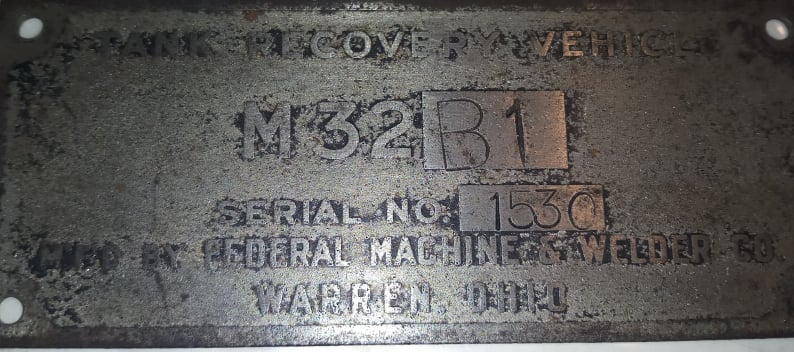
Federal Machine & Welder Co.. - M32B1 Tank Recovery Vehicle - Serial number 1530
SN 1530 was one of 400 "M32-M32B1s" reported to have been converted by Federal Machine & Welder from November, 1944 through May, 1945. By our math, 1530 would have been produced in February, 1945. With kind permission from Daniel Röttger.
Sherman-related armored vehicles
Original WW2 plates

Rock Island Arsenal - Serial Number 62 - M2A1 Medium tank
Here we have a brass dataplate from an M2A1 Medium Tank. The M2 series design, of course, influenced the subsequent designs of the M3 and M4 Medium Tank series. Rock Island Arsenal produced 94 M2A1s from December, 1940 through August, 1941. We "interpolate" that the first M2A1 was assigned Serial Number 19 (18 M2s had been built by RIA previously). Thus, by our math, Serial Number 62 would have been the 44th M2A1, and would have been accepted in May, 1941, and assigned US Army Registration Number 30859. Notice that the full year "1941" is cast, not stamped, into the plate in the lower left. The initials "N.F.R." seen stamped into the lower right would, without doubt, be those of Brigadier General Norman F. Ramsey, who was the commander of RIA at the time.

Baldwin - M3A3 Lee - Serial number 1099 - Built in July, 1942
The Baldwin plant was located in Eddystone, Pennsylvania, and was part of the Philadelphia Ordnance District. From August, 1942 to December, 1943, Colonel D. N. Hauseman was Chief of the Philadelphia O.D., and his initials can be seen stamped into the box at the lower right of the plate. All of the Grant dataplates and most of Lees that we have seen are made of cast brass, and have survived the years nearly unchanged. Sometime in the middle of 1942, the Ordnance Department ordered that dataplates be made of an alternate material in order to conserve brass. These have been variously described as “steel with a thin plating of nickel or cadmium,” or simply “pot metal.” They were subject to deterioration by rust as the protective clear coat, if any, wore off. We would judge that the example shown above is an original Baldwin plate, representative of one introduced on their Lees at the transition from brass to steel. It has survived time better than most steel plates, possibly because the tank was displayed inside a Museum for many years. Baldwin produced its last Grant in July, 1942, and our research suggests that all of their Grants were provided with brass dataplates.

Baldwin - M3A5 Lee - Serial number 1332 - Built in September, 1942
Photo via Colonel Renato Rocha

Chrysler Corporation - M3 Lee - Serial Number 4207 (British T-25751) - built in June, 1942
Photo courtesy of Rod Bellars

Baldwin Locomotive Works - M3A5 Grant - Serial Number T-23876 (373th Grant built by Baldwin LW) - built in May, 1942
Photo courtesy of Leife Hulbert
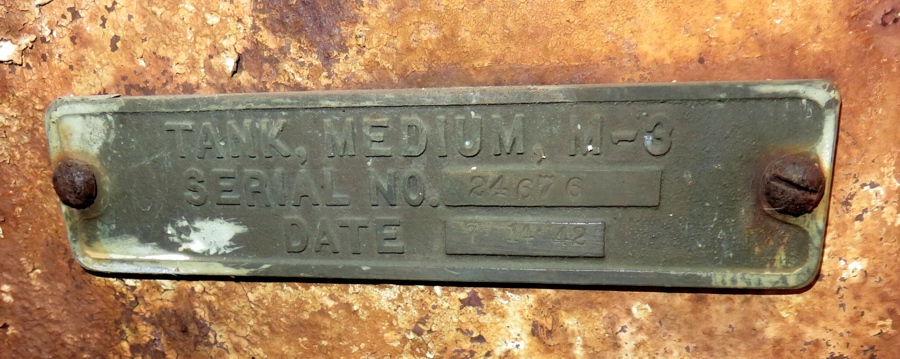
Pullman Standard - M3 Grant - Serial Number T-24676 - built in July, 1942

Montreal Locomotive Works Ltd. - Ram II tank - Serial number CT 40683 - 1942

Montreal Locomotive Works Ltd. - Ram II tank - Serial number CT 160162 - 1943

Montreal Locomotive Works Ltd. - Sexton SPG - Shop Number 1918 - Canadian WD Number 287 206 - 1945
Post-war / remanufacture plates

Ford - M4A3 75mm Sherman - Serial number 12084
Photo courtesy of Mike Haines

Ford - M4A3 75mm Sherman - Serial number 12369
Reconditioned on 14th May, 1952 by Brown & Root, Inc. Photo courtesy of Russ Morgan.
We have not come across any historic documentation or any period photos about the rebuild work that Brown & Root did on Shermans in the early 1950s. The only thing we have had to work with is what is evident on surviving tanks. Russ Morgan kindly permitted us to use a photo of his Brown and Root Tank Division dataplate. As can be seen in the box at the upper right, this M4A3 is Serial Number 12369 (originally built June 1943). We must assume that the box at the lower left provides the exact date that the reconditioned tank was accepted: "5-14-52" [May 15, 1952]. The initials "F.H.T." would be those of an official who accepted the rebuild on behalf of the US Government. We might guess that "R.I.O." stands for "Registered Inspection Officer." If any readers have any information about the time that Brown & Root reconditioned Shermans, we would be pleased to hear from you.
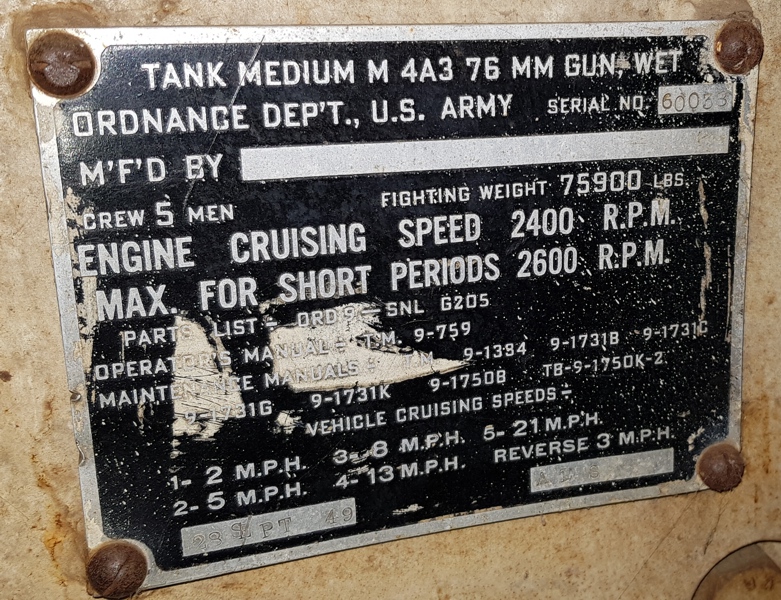
Chrysler - M4A3 76mm wet (HVSS) Sherman - Serial number 60038
Remanufactured on 28th September 1949

Pressed Steel Car - M4A1 76mm wet (HVSS) Sherman - Serial number 68148
Overhauled in 1950 at Watertown Arsenal

Pressed Steel Car - M4A1 76mm wet (HVSS) Sherman - Serial number 73836
Remanufactured for Mutual Assistance Defense Program in the 1950s


Fisher - M4A3E4 76mm VVSS Sherman - Serial number 48876
Remanufactured in August 1953 by Rock Island Arsenal (R.I.A.) - this tank was built as an M4A3(75) W
Photos courtesy of Hanno Spoelstra


Chrysler - M4A3E4 76mm VVSS Sherman - Serial number 56797
Remanufactured by Bowen McLaughlin York, PA (BMY) - this tank was built as an M4A3(105)
Photos courtesy of Claus Bonnesen
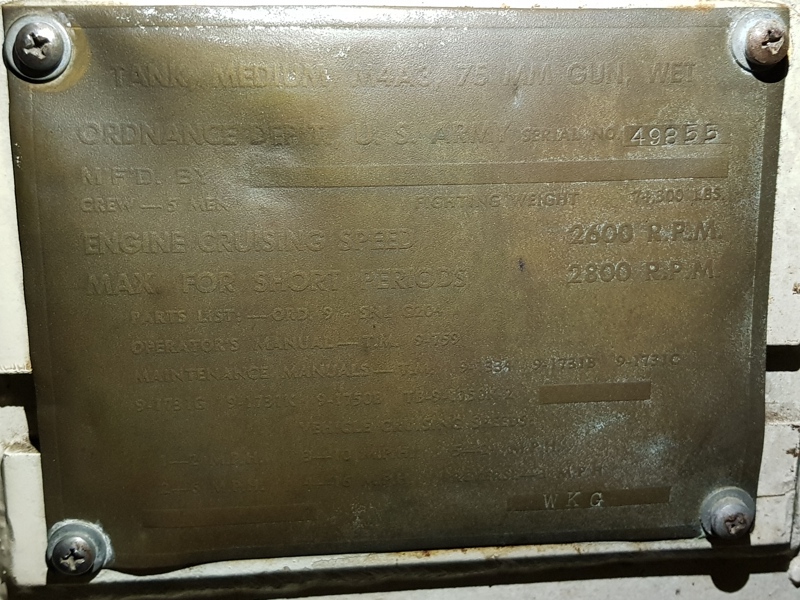
Fisher - M4A3 75mm wet (VVSS) Sherman - Serial number 49855
Photo courtesy of Don Moriarty - this is probably a remanufacture dataplate

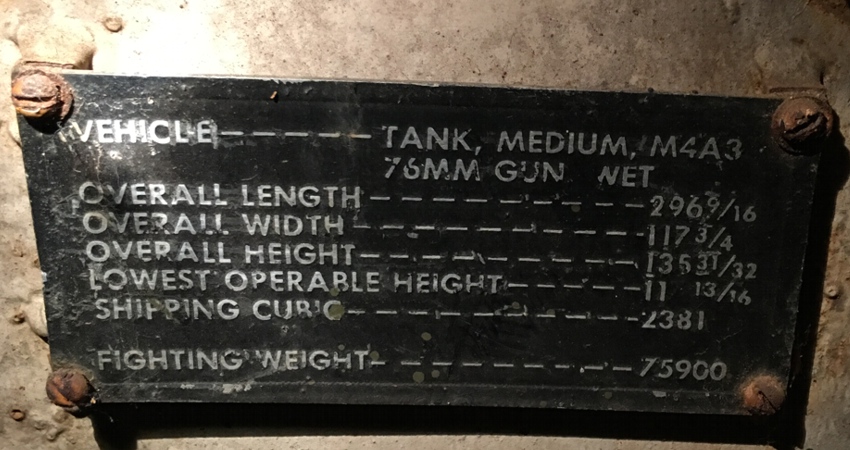
Chrysler - M4A3 76mm wet (HVSS) Sherman - Serial number 45310
Courtesy First Division Museum, Wheaton - this is probably a remanufacture dataplate
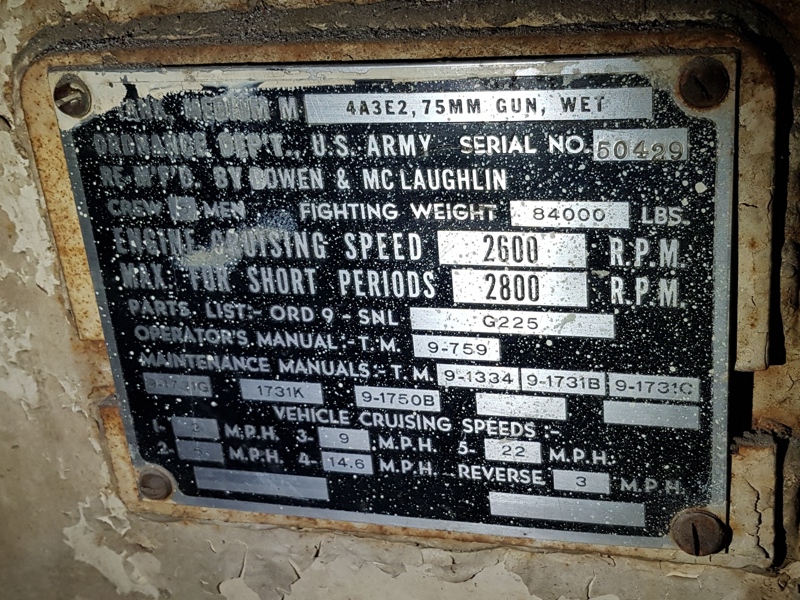
Fisher - M4A3E2 75mm "Jumbo" Sherman - Serial number 50489
Remanufactured by Bowen & Mc Laughlin

Fisher Body Div. General Motors Corp. - M36 Tank Destroyer - Serial number 300
Remanufactured for Mutual Assistance Defense Program in the 1950s
Photo courtesy of the owner, via Joe DeMarco


M36 Tank Destroyer - Serial number unknown
Remanufactured by Commerce International Co., Inc., part of 581 M36s rebuilt from Jan 1951 through Sept 1952.
Top photo courtesy of Giuseppe Franzoni

M7 Priest SPG - Serial number 463
The remanufacturer is not mentioned

M7B2 Priest SPG - Serial number 4463
Remanufactured by Pressed Steel Car Co. Inc.
Photo courtesy of Michael Lembo

M32B3 Tank Recovery Vehicle (HVSS) - Serial number 273
Remanufactured by Rock Island Arsenal
Photo courtesy of Kurt Laughlin

M74 Tank Recovery Vehicle - Serial number 466
Manufactured in March 1954 by Bowen & Mc Laughlin-York, Inc.
Photo courtesy of Michael Lembo
Reproductions
